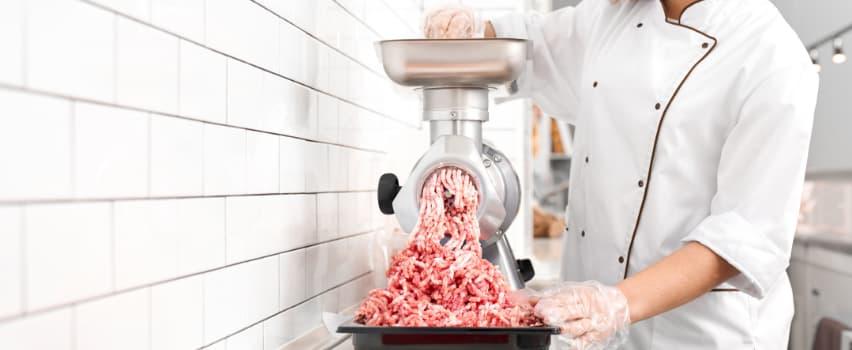Top 4 mistakes to avoid when using meat mincers
Meat mincers can be hugely valuable assets for your business, but like so many assets, it only performs as well as it’s looked after. That’s one reason why it’s always a good idea to ensure you’re fully up to speed with all the specific capabilities and requirements of your own meat mincer – and that your team receives regular training and re-training on how best to use it. That can help you avoid the potential consequences of some of the most common mistakes – we’ve detailed some of the most common ones below!
Skipping proper meat preparation
Before any meat enters the mincer, the very first step is to make sure it’s properly prepared – both to ensure consistent mince, and to protect the machine itself. For example, it’s a good idea to remove bones as this prevents damage to blades and other internal components, while trimming sinew and excessive fat avoids clogging and irregular texture.
It's worth noting that cold meat is easier to process because it stays firm, reducing smearing and helping the blade cut cleanly. Another good thing to do is to cut meat into smaller, evenly sized chunks before feeding them into the machine improves grinding speed and reduces the chance of jams. If the meat isn’t properly prepared, that not only increases wear on the mincer, but can also affect the safety and appearance of the final product.
Inconsistent maintenance
This is probably another relatively obvious one, but still worth saying! It’s really important to have a proper maintenance schedule for your mincers, so you can be sure of smooth performance and food safety. Ideally, you or your team will thoroughly clean it after every use – this removes trapped meat particles and fat, preventing bacterial growth and contamination.
Blades and plates suffer wear over time, so they need to be inspected regularly; dull blades reduce cutting efficiency, cause uneven mince, and increase the machine’s workload. Replacing or sharpening these components keeps the mincer operating at peak performance. It’s also crucial to lubricate moving parts as recommended, as this reduces friction and prevents premature wear or mechanical faults. All this can help you minimise the risk of unexpected breakdowns, costly repairs, and potential safety hazards, all of which can interrupt busy butchery workflows.
Overloading the mincer
Overloading the mincer is a fairly common mistake, especially by junior employees. Unfortunately, exceptionally large quantities (or pieces beyond its capacity) can place undue stress on its motor and internal parts. That may cause the motor to overheat when pushed beyond limits, potentially causing damage or automatic shutdowns that interrupt production.
It also increases the chance of blockages or jams, which might need the machine to be stopped and manual cleared – all of which takes time. On the other hand, careful portion control allows the mincer to work efficiently without strain, ensuring a steady flow of product and preventing unnecessary downtime. It’s therefore really important to make sure that anyone using the machine is properly familiarised with the mincer’s recommended capacity and avoid rushing the process, which can extend the life of the equipment and improve safety.
Using the wrong attachment or blade
The mincer’s performance depends heavily on using the correct blade and plate attachments for the intended product. Different dishes or products require various textures, from coarse cuts for sausages to very fine mince for pâtés or spreads.
That means it’s important to avoid using a plate with holes that are too large or small, as this results in inconsistent textures and can cause the motor to strain unnecessarily. Some attachments are designed for special purposes, such as grinding tougher cuts or mixing additives into the meat. In fact, one of the best ways to maximise efficiency and product quality involves making sure that you’re choosing the right attachments and changing them regularly to suit the product type. And of course, regularly inspecting the attachments to ensure that they’re remain sharp, undamaged, and compatible with the mincer.
Of course, even the best-maintained meat mincer will come to the end of its operational lifespan occasionally – and when that time comes, that’s exactly where we can help here at Butchers Equipment Warehouse. We supply a great range of meat mincers and butchers machinery, and all for the very best prices. And of course, if you’ve ever got any questions or need any advice about our products, just give our team a call on 01254 427 761. We’re always happy to help!




